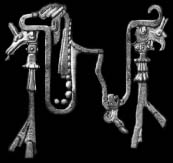 |
|||||
|
|
|
Diet and other precautions
From Luis Eduardo Luna, 1991:10,13,14,17,48Vegetalistas, like their counterparts the Indian shamans of many indigenous groups of the Upper Amazon, claim to derive healing skills and powers from certain plant teachers - often psychoactive - believed to have a mother (cf. Luna 1984). Knowledge -- particular medicinal knowledge -- comes from the plants themselves, the senior shaman only mediating the transmission of information, protecting the novice from the attack of sorcerers or evil spirits, and indicating to him or her the proper conditions under which transmission is possible.[4] Among the plant teachers large trees are considered particularly powerful.
The necessity of diet -- which also includes sexual segregation -- to learn from the plants was stressed by every vegetalista I met. The body has to be purified to communicate with the spirit realm. Only in this way will the neophytes acquire their spiritual helpers, learn icaros (power songs), and acquire their yachay, yausa, or mariri -- phlegm the novice receives at some point diuring his initiation, either from the senior shaman or from the spirits. Particularly important are the icaros.... The icaros constitute the quintessence of shamanic power. The icaros and the phlegm -- both of which have material and immaterial qualities -- represent the transference of the spirits of each plant, with all their knowledge and theriomorphic and anthropomorphic manifestations, into the body of the shaman.[5]
Diet: "During the month ... we ate only fish, plantains, and rice without salt or any spices, and only twice a day ... We took ayahuasca once a week" (cf. Luna 1991:14). "We were supposed to be far from people who were not keeping the diet. There were people coming there, the relatives of the patients, women of fertile age. It was not possible to learn anything in this way" (cf. Luna 1991:16). "He gave me a mixture of Psychotria viridis and tobacco to drink every four days. He told me that it was like this he had learned medicine: If the diet and isolation were maintained long enough, the plants themselves would reveal their properties in a sort of telepathic way" (cf. Luna 1991:17). You can only become a good vegetalista by keeping a diet or fasting for years,[81] then you become one that knows the science of the muraya, of the sumi, and of the banco, which are the three highest degrees in the traditional vegetalista medicine in the Amazon (cf. Luna 1991:48).
Footnotes4 - The importance of psychotropic plants in the shamanistic practices of many indigenous groups of the Upper Amazon is paramount. For the Yagua, for example, contact with the spirits of the plants by ingesting them is considered "the only path to knowledge" (Chaumeil 1983:33). Psychotropic plants correspond to the category of plants known among the Shipibo as muraya-cai = shaman-makers (Gebhart-Sayer 1986:203). These plants reveal the "real" world, while the normal world is often considered illusory (cf. Chaumeil 1983:102 for the Yagua; Langdon 1979b:78 for the Siona: Harner 1972: 134 for the Jivaro). Also see Harner 1973: The Sound of Rushing Water
5 - The same plant may manifest itself to the vegetalista by means of several spiritual figures, all having common features among them, in such a way that there is no extreme contradiction between one vision and another.
81 - The term dietar (to keep a diet) includes not only dietary restrictions (not eating salt or condiments, sweets, pork fat ,etc.), but also sexual segregation and other prerequisites, as for example avoiding the sun or making food, etc. (cf. Chevalier 1982:346). One of the reason shamanism is declining among Indians and mestizos alike is because young people don't bother to keep the difficult diet (cf. Huxley 1963:192; Taussig 1987:418; Gebhart-Sayer 1987:175).
Bibliography
Chaumeil, Jean-Pierre 1983 Voir, Savoir, Pouivoir. Le chamanisme chez les Yagua du Nord-Est peruvien. Paris, Editions de l'Ecole des Hautes Etudes en Sciences Sociales. Chevalier, Jacques M. 1982 Civilization and the Stolen Gift: Capital, Kin, and Cult in Eastern Peru, University of Torontoi Press. Gebhart-Sayer, Angelika 1984 The Cosmos Encoiled Indian Art of the Peruvian Amazon, New York, Center for Inter-American Relations 1986 Una Terapia Estetica. Los Disenos Visionarios del Ayahuasca entre los Shipibo-Conibo. America Indigena 46(1)189-218. Mexico. 1987 Die Spitze des Bewusstseins. Untersuchungen zu Weltbild und Kunst der Shipibo-Conibo. Hohenscaftlarn, Klaus Renner Verlag. Harner, Michael J. 1972 The Jivaro People of the Sacred Waterfalls, Berkeley, University of California Huxley, Francis 1963 Affable Savages: An Anthropologist Among the Urubu Indians of Brazil, London, Rupert Hart-Davis. Langdon E. Jean 1979b The Siona Halliuicinogenis Ritual, Its meaning and Power. In John H. Morgan (ed.), Understanding Religion and Culture: Anthropological and Theological Perspectives. Washington University Press of America. Luna, Luis Eduardo 1984 The Concept of Plants as Teachers Among Four Mestizo Shamans of Iquitos, Northeast Peru, Journal of Ethnopharmacology 11135-56. 1991 Ayahuasca Visions: The Religious Iconography of a Peruvian Shaman, North Atlantic Books Taussig, Michael 1987 Shamanism, Colonialism, and the Wild Man: A Study in Terror and Healing. The University of Chicago Press.